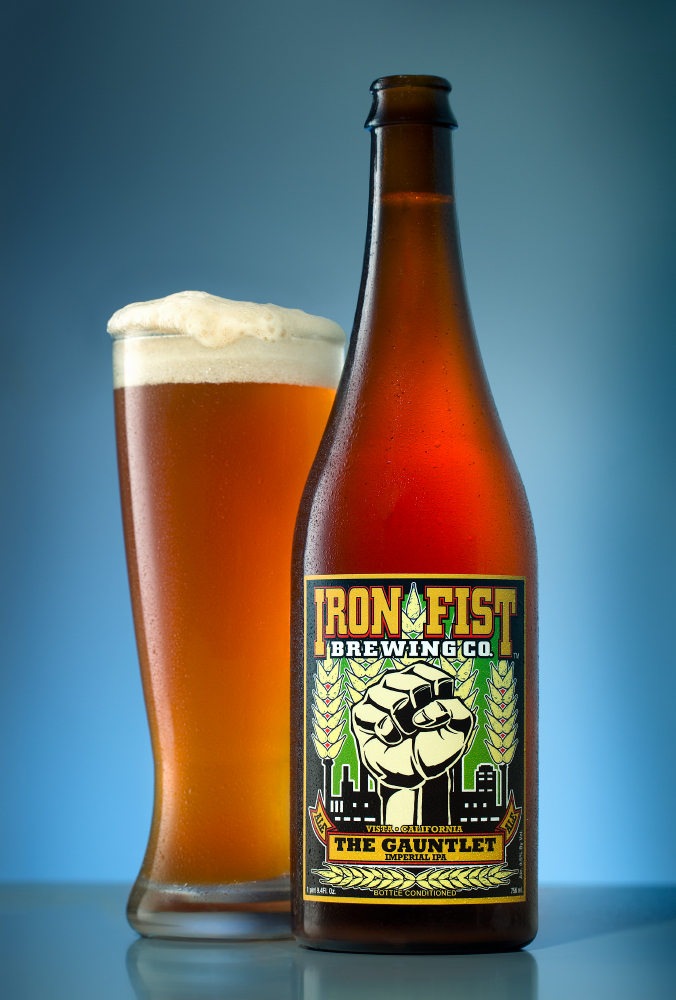
Beer Photography – Lighting Setup and Technique
Product photography, and especially beverage photography involving glass, is a true melding of technical geekery and artistic decision making. Although the challenges of photographing glassware and liquid can be at times frustrating, the rewards are high. It’s the feeling of building an image, as if building a piece of furniture. You look at examples, lay out a design, start to assemble the parts, and then you invariably will stray from that design in actual practice which produces something unique. I used to hate tinkering for several hours on one shot, but now I can truly say I enjoy it. Using some tips from my friends at Photigy, as well as their Facebook support group, I set out to make this photo of Iron Fist Brewing Co.’s “The Gauntlet” IPA.
This is the setup.
Lighting
The shooting surface is an orphaned part from Ikea. A gray surface was the closest thing I had to metal to represent “Iron”, but the gray looked a little flat to me so I ended up shifting the color toward blue in post production.
The camera was secured on a tripod so that I could keep everything static for comping together multiple shots in the end, if needed. I used a 5d Mark III, with a Lee circular polarizing filter, and 100mm f/2.8L macro lens.
There are four lights being used. The main light is fitted with a small reflector, as well as a layer of diffusion material, followed by a polarizing gel. The camera was also fitted with a circular polarizing filter. This way we can set the camera’s polarizer for the scene and rotate the polarizer on the light until the reflection of our main light disappears. It didn’t disappear completely, so there were still some light reflections to clone out in the end. However, they were much smaller and darker than they would have been without the polarizing gel.
The second light is a strip box at camera left, shot through a diffusion screen of Rosco #3026 diffusion material. Angling the softbox so that it just touches the diffuser will create a highlight on the glass that has a defined edge on one side and tapers off more smoothly on the other. The trick is spacing the glass and bottle just right so that the highlight is not interrupted. If there are small inconsistencies in the highlight they can be addressed in post.
The third light is aimed at the background, and has a blue gel taped to it to make the white background paper appear light blue.
The fourth light is a speed light (Lumopro LP180) laid on the table behind the bottle and glass. This creates the glow through the glass so that you can see the liquid. This one was re-positioned many, many times by hand until the desired result was reached.
Post Production/Retouching
The trickiest element in this shot was the foam. When first opened, the beer was alive with carbonation, but once it settled is was hard to revive. I deployed the Rob Grimm Chopstick Jedi Move, but I really only got one good resurgence of foam, and clicked as many captures during it’s rise and fall as possible. I ended up comping in a modified version of one of the foam spillovers to give the image some tension.
I also comped in an image where the table looked glossy, but did not have the shadows from the backlight, in order to keep the shadows looking natural.
Lastly, I retouched the small highlights off the bottom and off the bottle to make things look cleaner, added some vignetting and color adjustments to the backdrop and foam, and did some global contrast and sharpness adjustments.
Next time, I’ll definitely have more bottles of the beer on hand and a pump to get it in an out of the glass without moving the set around.
I spent a few hours shooting and editing for one final image, but now that I have a workable setup and routine I can prepare and execute much, much faster on future beer shoots. If you’re interested in learning beer photography, the key is practice, practice, practice! I always suggest practicing when you have free time and you’re not working on the clock. This way you have complete creative freedom and time to experiment with your lights without the pressure of a deadline.


